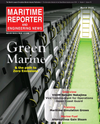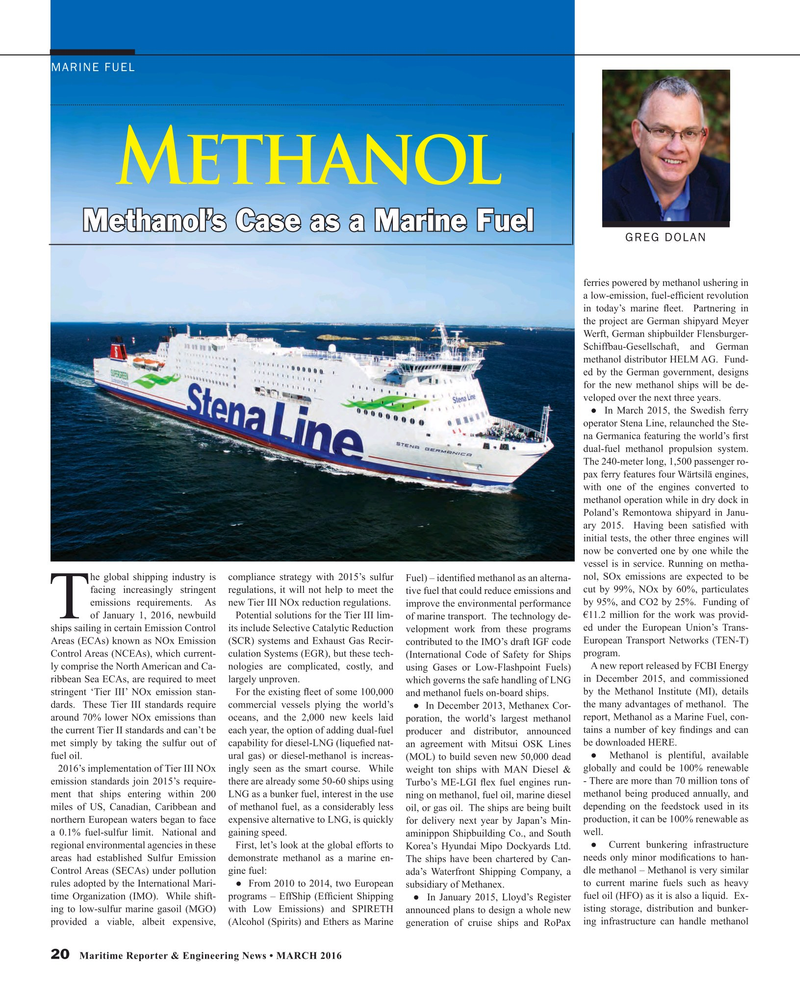
Page 20: of Maritime Reporter Magazine (March 2016)
Green Marine Technology
Read this page in Pdf, Flash or Html5 edition of March 2016 Maritime Reporter Magazine
MARINE FUEL
Methanol
Methanol’s Case as a Marine Fuel
GREG DOLAN ferries powered by methanol ushering in a low-emission, fuel-ef? cient revolution in today’s marine ? eet. Partnering in the project are German shipyard Meyer
Werft, German shipbuilder Flensburger-
Schiffbau-Gesellschaft, and German methanol distributor HELM AG. Fund- ed by the German government, designs for the new methanol ships will be de- veloped over the next three years.
? In March 2015, the Swedish ferry operator Stena Line, relaunched the Ste- na Germanica featuring the world’s ? rst dual-fuel methanol propulsion system.
The 240-meter long, 1,500 passenger ro- pax ferry features four Wärtsilä engines, with one of the engines converted to methanol operation while in dry dock in
Poland’s Remontowa shipyard in Janu- ary 2015. Having been satis? ed with initial tests, the other three engines will now be converted one by one while the vessel is in service. Running on metha- nol, SOx emissions are expected to be he global shipping industry is compliance strategy with 2015’s sulfur Fuel) – identi? ed methanol as an alterna- facing increasingly stringent regulations, it will not help to meet the tive fuel that could reduce emissions and cut by 99%, NOx by 60%, particulates emissions requirements. As new Tier III NOx reduction regulations. improve the environmental performance by 95%, and CO2 by 25%. Funding of €11.2 million for the work was provid-
Tof January 1, 2016, newbuild Potential solutions for the Tier III lim- of marine transport. The technology de- ships sailing in certain Emission Control its include Selective Catalytic Reduction velopment work from these programs ed under the European Union’s Trans-
Areas (ECAs) known as NOx Emission (SCR) systems and Exhaust Gas Recir- contributed to the IMO’s draft IGF code European Transport Networks (TEN-T)
Control Areas (NCEAs), which current- culation Systems (EGR), but these tech- (International Code of Safety for Ships program.
A new report released by FCBI Energy ly comprise the North American and Ca- nologies are complicated, costly, and using Gases or Low-Flashpoint Fuels) ribbean Sea ECAs, are required to meet largely unproven. which governs the safe handling of LNG in December 2015, and commissioned by the Methanol Institute (MI), details stringent ‘Tier III’ NOx emission stan- For the existing ? eet of some 100,000 and methanol fuels on-board ships.
the many advantages of methanol. The dards. These Tier III standards require commercial vessels plying the world’s ? In December 2013, Methanex Cor- around 70% lower NOx emissions than oceans, and the 2,000 new keels laid poration, the world’s largest methanol report, Methanol as a Marine Fuel, con- the current Tier II standards and can’t be each year, the option of adding dual-fuel producer and distributor, announced tains a number of key ? ndings and can met simply by taking the sulfur out of capability for diesel-LNG (lique? ed nat- an agreement with Mitsui OSK Lines be downloaded HERE.
? Methanol is plentiful, available fuel oil. ural gas) or diesel-methanol is increas- (MOL) to build seven new 50,000 dead 2016’s implementation of Tier III NOx ingly seen as the smart course. While weight ton ships with MAN Diesel & globally and could be 100% renewable - There are more than 70 million tons of emission standards join 2015’s require- there are already some 50-60 ships using Turbo’s ME-LGI ? ex fuel engines run- ment that ships entering within 200 LNG as a bunker fuel, interest in the use ning on methanol, fuel oil, marine diesel methanol being produced annually, and miles of US, Canadian, Caribbean and of methanol fuel, as a considerably less oil, or gas oil. The ships are being built depending on the feedstock used in its production, it can be 100% renewable as northern European waters began to face expensive alternative to LNG, is quickly for delivery next year by Japan’s Min- a 0.1% fuel-sulfur limit. National and gaining speed. aminippon Shipbuilding Co., and South well.
? Current bunkering infrastructure regional environmental agencies in these First, let’s look at the global efforts to Korea’s Hyundai Mipo Dockyards Ltd. needs only minor modi? cations to han- areas had established Sulfur Emission demonstrate methanol as a marine en- The ships have been chartered by Can-
Control Areas (SECAs) under pollution gine fuel: ada’s Waterfront Shipping Company, a dle methanol – Methanol is very similar to current marine fuels such as heavy rules adopted by the International Mari- ? From 2010 to 2014, two European subsidiary of Methanex.
time Organization (IMO). While shift- programs – EffShip (Ef? cient Shipping ? In January 2015, Lloyd’s Register fuel oil (HFO) as it is also a liquid. Ex- ing to low-sulfur marine gasoil (MGO) with Low Emissions) and SPIRETH announced plans to design a whole new isting storage, distribution and bunker- provided a viable, albeit expensive, (Alcohol (Spirits) and Ethers as Marine generation of cruise ships and RoPax ing infrastructure can handle methanol 20 Maritime Reporter & Engineering News • MARCH 2016
MR #3 (18-25).indd 20 3/2/2016 9:56:17 AM

 19
19

 21
21
